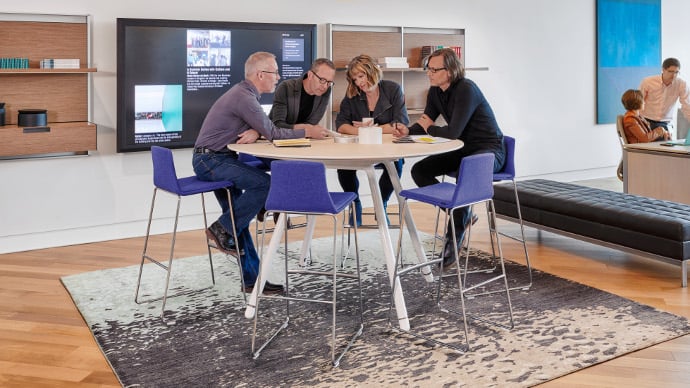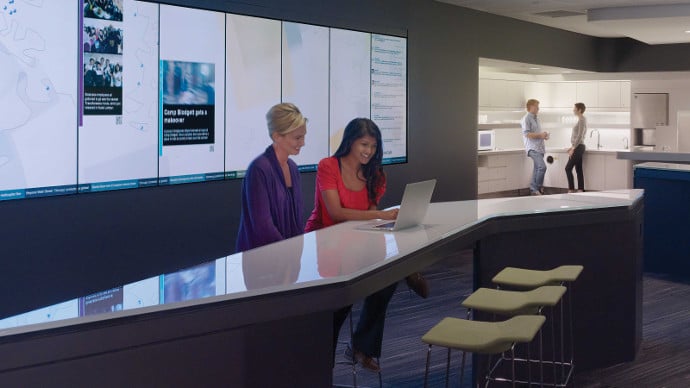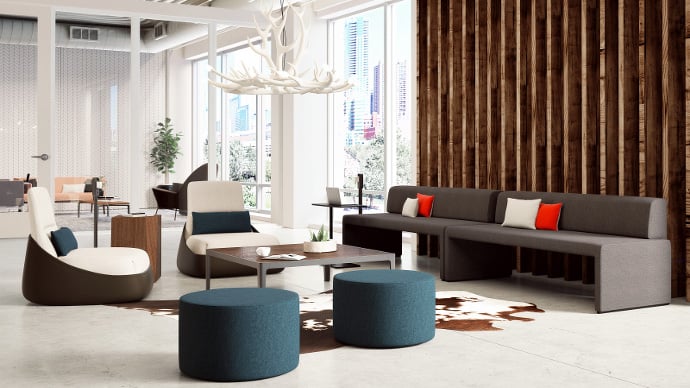Though no one would have wished for the pandemic, it has accelerated discussions around how we can improve the world of work.
As people were forced to work from home it allowed them to recognise what they need from the work experience to feel happy, fulfilled, and to be productive. And it’s enabled organisations and employees to appreciate the true value of the workplace.
Here. we highlight 4 things the last year has taught us about what we need from work and the workplace in order to thrive.
1. The role of the office as a space to collaborate will be more important than ever
Businesses have always relied on collaboration. When people work together they become aligned to the same goals, learn from each other’s different skills and experiences, and are better able to solve problems. Working with others also boosts morale, provides people with a sense of belonging and helps them to form bonds with colleagues.
The workplace has always provided this space for collaboration. So when people were forced to work from home due to the pandemic, collaboration suffered. According to the Steelcase WorkSpace Futures report, 63% of workers saw a decline in time spent working with others during the pandemic.
The office provides a space for teams to come together and build on each other’s ideas, make revisions and bring new concepts to life.
As organisations and workers look ahead to the return to the office, the focus on collaboration will be sharper than ever.
Meeting spaces must cater for different types of collaboration, whether formal or informal, planned or spontaneous. Furniture must support a range of postures, including high stools and tables to encourage active collaboration or lounge chairs for relaxed conversation.

The workplace will also need to support mixed presence collaboration; occasions when some members of a team are present in the office and others are at home. Collaboration tools like virtual whiteboards will become more commonplace. And we could see virtual reality replace video conferencing to better mimic face-to-face interaction.
“As more organizations develop remote-work policies, virtual reality is emerging as a tool whose collaborative capabilities extend far beyond the offerings of video chat-rooms and onscreen meetings.” Harvard Business Review
2. Workers value social connection in the office
Human beings crave social connection and the pandemic has been an immense struggle for people in this respect as they are forced to keep their distance from those outside their household.
People are also missing the social connection they get in the office. According to the Gensler Workplace Survey 2020, the top reasons people like going to the office are:
- Working in-person with my colleagues - 56%
- Socialising with my colleagues - 45%
- Impromptu face-to-face connections - 37%
Just as the office will play a bigger role as a space to collaborate, it also needs to provide people with the social connection they crave. Break out areas and the work cafe have provide a place for people to meet and socialise in a less formal space, and these will be even more important in a post-covid world.

Social spaces should be designed in such a way that they encourage interaction, while offering the flexibility to allow for social distancing when it’s required. Casual seating areas can be enhanced with rugs and lighting to create a more informal environment - an environment more akin to the spaces they’ve enjoyed while working at home.
These shared spaces also need to support those seeking a more relaxed space to work. Even if they don’t want to interact with others, they still get to soak up the energy of being surrounded by their colleagues and feel a sense of belonging.

When first bringing people back to the office, shared spaces will need to support social distancing and the cleaning protocols required to create a safer work environment.
3. Homeworking is here to stay
The pandemic caused more of us to work from home than ever before. And research indicates that homeworking will continue to play a bigger part of our lives in a post-covid world:
- 67% of UK office workers want a hybrid of home work and office work
- 73% of the workforce believes their company should embrace some level of working from home
Many workers have become accustomed to the autonomy of working from home and will be reluctant to give that up entirely. More companies are likely to adopt flexible working practices, recognising the health and wellbeing benefits it offers employees.
“A flexible working model best facilitates balance, reduces stress and improves employee wellbeing more than solely working from either the home or the office.” BCFA
Providing workers with more control over where, when and how they work will also be important for attracting and retaining the best talent.
In this new reality, there will be an even greater imperative to make sure both offices and homes are furnished and equipped properly to accommodate this new hybrid workforce.
Some organisations are already providing their employees with homeworking furniture and equipment. And companies like IE are helping organisations to facilitate the delivery of homeworking furniture direct to workers’ home addresses.
.jpg?width=690&name=20-0143065%20(1).jpg)
At IE, we have launched a homeworking furniture shop for employees to kit out their home offices. We can also help you create their own custom catalogue of furniture products for your employees, and add it to your own secure and private e-portal for your company.
4. Adaptability will be key to managing future disruption
When organisations were plunged into new ‘work from home’ territory, it triggered an onslaught of organisational challenges. Teams had to find new ways to communicate virtually; prompting a mass sign up to tools like Slack and Zoom. Companies had to navigate getting people the equipment they needed to be able to work from home. And they had to align the organisation to continuously changing business priorities in the context of Covid-19.
It’s this ability to adapt that will see companies through future disruption, be it another pandemic, social or political uncertainty, or climate-related challenges.
The workplace must also be highly adaptable to change. No one knows what the future will hold and the workplace will need to be designed with future disruption in mind. Reconfigurations may include adding casters to desks, screens and storage units so they can be moved to accommodate greater and less social distancing.










